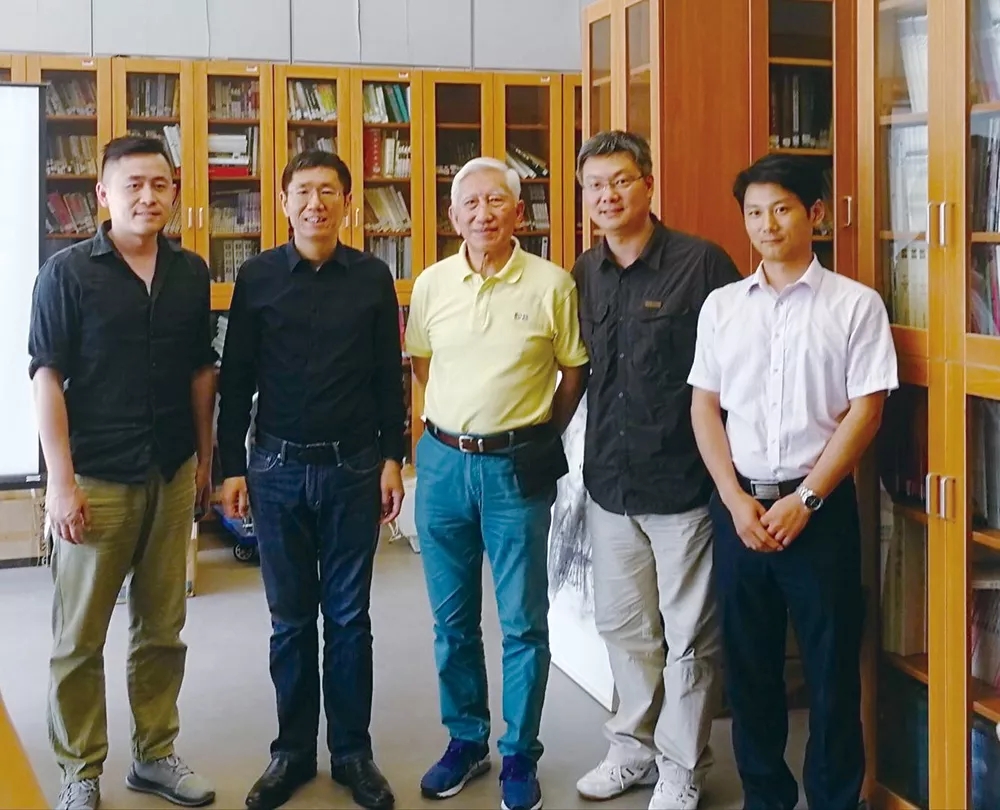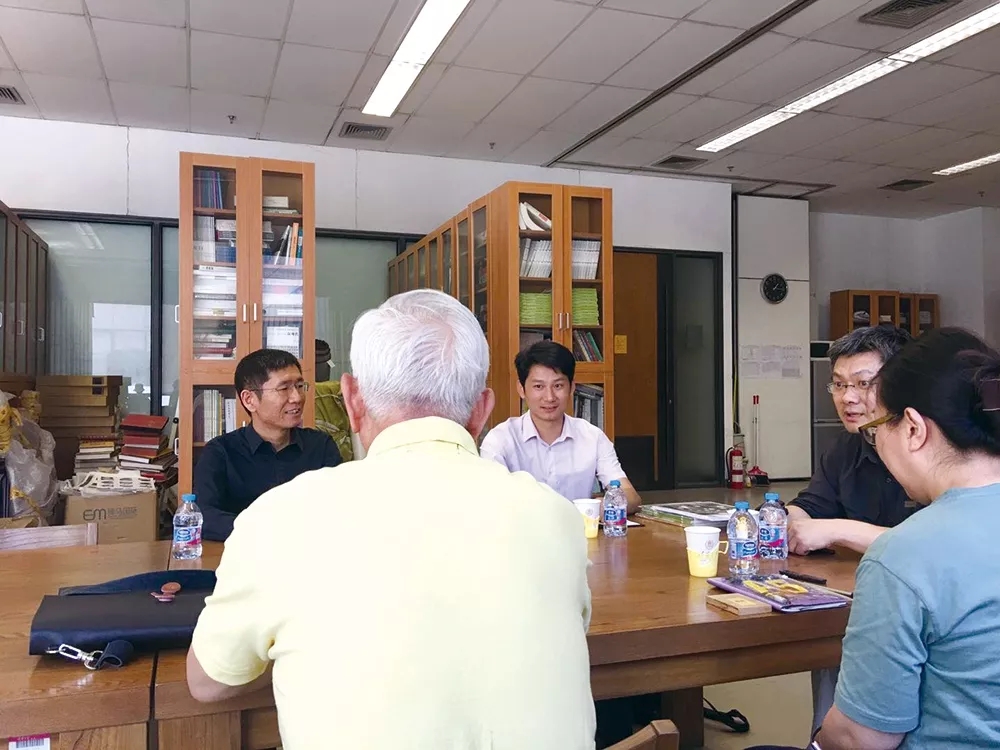C-bit talk | Liu Guanzhong / Liu De: Designing
DateTime:2019-4-27 | Hits:4660
c Interview: Jiang Hongbin Li Jie Li Ye
c Interviewed: Liu De Liu Guanzhong


Liu De (left) Liu Guanzhong (right)
“The magazine is fortunate to give a professor to the Academy of Fine Arts of Tsinghua University, a doctoral tutor, the first batch of senior professors of liberal arts, the editor-in-chief of Design magazine Liu Guanzhong and the co-founder of Xiaomi Technology, the senior vice president of Xiaomi Group, and the head of the group organization department, Liu De. This led to a new model in the topic--talk. The two design theory and practice pioneers revolved around "how design drives Chinese enterprises to expand and expand into the world" and "millet mode". Topics such as the "Millet Eco-chain" are unfolding."
● "In many large design companies, a designer's annual output value is only about 150,000, which is not as good as an industrial worker. For the future China, this is a crossroads. Now it is about transformation, enterprise transformation, design company. Transformation is exploring its own path. Xiaomi’s path cannot be ignored. It brings a new management system.”
- Liu Guanzhong
● "We have given the designer a new role - the party of the product. So the designer's thinking about the product begins to be pure and real, and will not change the principle for other reasons."
- Liu De
The millet model is very influential in the current market. What kind of development has Xiaomi experienced since its inception?
Liu De: I first worked as a design company in school. At that time, I had an understanding of design services, but I didn't understand how companies do industrial design. After doing Xiaomi in the past few years, the feeling of the enterprise side will be stronger. When we were designing a company, we had a slogan. The satisfaction of Party A is our greatest pursuit. It is obviously not correct today. When we start to do business, we are our own party. This is the biggest difference between Xiaomi and design companies.
In Xiaomi, in addition to a separate design team for mobile phones, there are more than 200 product categories, and the designer has only 14 people. Others seem to be highly efficient. The essential reason is that there is no Party A, and the designer is his own party. When everyone first arrived at Xiaomi, they still had Party A's consciousness. Later, it took us a while to change this idea and tell the designers that it is very important that the design team is Party A and which tone to use to do things.
There are several characteristics in summary. First, think about things before you start. We believe that Japan's white electricity is too "su", and Apple's technology is too strong, so let everyone "grab" the tone between Apple and Japan's white electricity, let everyone do things in this logic; second, pay attention to basic functions. At the time of design, 80% of the attention is placed on the basic functions of the product, and the basic functions of the product are satisfied by changing the useless decoration. That is, the two ideas mentioned at that time are “simple shape and direct function”. After that, we found that the more we do this, the closer the products are designed. What's more interesting is that it is easy to form a language after a large number of categories, which is reflected in different products. Slowly, the language that is unique to Xiaomi is formed.
Why Xiaomi has participated in many international awards, and there are several logics. First, the designer needs to be recognized, so we encourage everyone to go out and participate in the design awards. In 2017, Xiaomi got about 200 design awards in half a year, such as Red Dot, iF, G-Mark, etc. It was all very difficult to get the gold medal, so I think 2017 is good for Xiaomi. One year. I remember that the Japanese G-Mark Design Awards jury said in a gold medal to Xiaomi that one of the reasons is to alert the Japanese industry to this. "If you don't work hard, you are being overtaken by a Chinese company."
We have given the designer a new role - the party side of the product. So the designer's thinking about the product begins to be pure and true, and will not change the principle for other reasons. All of Xiaomi's designers have a very high training density, and the team only needs a precise design logic to quickly find a “road”.
In the past two years, there has been a good phenomenon. Chinese design has been highlighted in many product fields for three reasons: First, there are a large number of young designers in China; second, a large part of the designers have enough training density; It is the improvement of the aesthetic quality of the whole people and the market competition mechanism.
I remember when I was in my freshman year, I ran from the Polytechnic University to the Central Academy of Technology, and I wanted to know how they taught. Today, I have been studying for more than 20 years. When I graduated, apart from our own pursuit, everyone did not understand the industry. But today is completely different. During this time, China has undergone tremendous progress.
In these 20 years, China's design industry has given designers motivation in many ways. The first motivation was the early explorers and enlighteners. With Mr. Liu as the representative, these people brought the concept from overseas and told everyone what industrial design was. Before that, there was no such thing. The second motivation was the transfer of global manufacturing industry to China, bringing Western technology. awareness. This year China’s industrial design is very strong, because the industry is here; the third wave of power is that after the first wave of communicators, a large number of Chinese students began to go out to study and bring in the outside information, they are different from the early enlighteners. It has entered the practical stage; the motivation of the fourth stage is the rise of strong consumption in the Chinese market, and everyone is beginning to have a demand for “good things”. I think this is a strong driving force for the entire Chinese design industry.
Being a designer in China today is very good from me. What is valuable is that once this momentum is formed, from now on, 10 years and 20 years, it will usher in a more golden era. With the rise of consumption, the maturity of consumers, everyone began to appeal to good products, and more practitioners and graduates appeared, and Chinese manufacturing began to be refined. I think the manufacturing industry may really be welcoming a 20-year period of good fortune.
Liu Guanzhong: The designer walked from the design company to Xiaomi and became the master of the house. You can find a way that everyone agrees with through exploration. Its premise is that the mechanism of Xiaomi itself allows, and the formation of this mechanism is very important. Because most of the domestic design companies are small and medium-sized design companies, they often follow the direction of Party A. I call it "guerrilla guerrilla", and I can't play it if I want to play it. One needs Party A, and the other is that within such a short period of time, if you want to rise, you can't get up.
The awards sponsored by the Ministry of Industry and Information Technology are basically large companies because of their strength. The design company has no strength and resources. Even if you want to do it, the cycle determines that it is impossible to make great efforts. So I am very grateful to Xiaomi for this mechanism. You say it's a business, but it's actually a design-driven business, unlike a typical market-driven business. I think this is the place where Xiaomi is most worth learning. Driven by design is also a way of doing business. I believe that this is a model that China must refer to in the next 10 years and 20 years of enterprise transformation or design company transformation. It is critical to make the role of design to the utmost in terms of mechanism.
In many large design companies, a designer's annual output value is only about 150,000, not as good as an industrial worker. For the future China, this is a crossroads. Nowadays, we are all about transformation, enterprise transformation, and design company transformation. We are all exploring our own path. Xiaomi’s path can not be ignored. It brings a new management system.

The designer himself is Party A. How is this mechanism formed? How can companies make the role of design to the utmost when formulating management mechanisms?
Liu De: All the reasons are driven by market competition. Competition is the driving force behind everything. Xiaomi’s early main business was to make mobile phones, and the industry was very competitive. So first, we have to find competitive hands in a highly competitive industry, including technology, supply chain, capital competition, etc. Design is an important part of the competition. Xiaomi has high requirements for design in the early days. I ask these entrepreneurs that you can't ignore design. It is precisely because of the importance, so in the partners of Xiaomi, I was born in industrial design. Two of the early seven people were designed and had a professional background.
The second reason, due to the special emphasis on design, design decisions go directly to the company's ultimate decision-making level. Mr. Lei has even reached the state of “cleanliness” for exquisite products. I rarely see engineers have such “design cleanliness”, which is the advantage of Xiaomi.
For the third reason, we choose the best people from all walks of life to join the project team. These people are knowledgeable, pursued, have a good educational background and an international perspective. Finding the strongest player to do it is a very important slogan for Xiaomi. A good engineer can top a hundred or even a thousand users, so find the best, first-line designer. There are a lot of young designers in China who have enough training density to get into a state that “has encountered this layer of window paper, but has not broken it”. We have a lot of interviews with such designers. This leads to the inside of Xiaomi, an ordinary designer may be the director level in other design companies. There are two types of people that we attach great importance to. The first category is people with sufficient training density. They have experience in design and they are "a layer of window paper". The second category is young people who we think are talented in the design field. . These two kinds of people have their own advantages. The people with rich experience have comprehensive abilities. From sketching to communicating with small factories, you can know how to push the design step by step. The second kind of young people are smart, once they give TA a correct path. The growth rate will be very fast. So this is a good team team.
In addition, give the designer the right to speak. Xiaomi's eco-chain model allows designers to have a high voice in the process from product definition to product design to cost control. But now it's a bit too high. We are also correcting this. Because sometimes the personal pursuit of the designer will bring huge costs to the company, but this is a necessary price to form a respectful design atmosphere. These costs are inputs, and once they are built, the designers will slowly mature, begin to form cost awareness, and communicate better with project managers and product managers. This is probably the logic in the millet system. Why do we say that design director is important? Because TA is responsible for making logic for the company, and then materializing it into the form and shape of the product.
Therefore, on the one hand, it is the incentive of market competition, on the other hand, the awareness of the team and the team is good enough.
Now China may also enter an INHOUSE era. Why do you say that? Because today's product competition is a comprehensive competition, it combines technological processes and manufacturing costs to an unprecedented level. At this time, a completely "peripheral" design company can't get in as much information as it can't get in. I think that when the company is in the stage of comprehensive competition, INHOUSE will start to rise. In the next decade, this INHOUSE may have a huge opportunity, because this is the process of achieving “from scratch, from excellence to excellence” in the entire Chinese society. From solving problems to getting better and better, there may be diversity in the future.
In the next decade, an era of elegant living will slowly emerge. When we talk about elegant life, we can talk about the era of big consumption. Today China has entered the era of big consumption. We often use an example to say that an American uses 12 towels a year, while the Chinese use two towels a year, a difference of ten in the middle. These ten towels will be complemented in the next decade. From the era of big consumption to the era of elegant life, everything began to become as refined as the Song Dynasty.
What is the signal of the elegant era? For example, about three or four years ago, a friend of mine came, and it was already November. He took a very delicate fan, and I was surprised. He said: "I bought a few of this fan, I want to customize it. Whoever likes me will give him a hand." I saw it, it was really delicate. This thing makes me very emotional. Pushing back for 20 years, doing a good fan may not be able to support yourself. But today you can make a fine fan, a delicate cup, you can live very well. why? Because a new era is coming.
Such an era will bring huge market space. In addition to the large-scale production of designers in large enterprises, there will be requirements for designers who are doing a variety of products, there will be huge opportunities in the design field, and great progress. I think it is a good thing.
When we are a design company, we are a company that admires small and beautiful, but when you get to a big business, you will find that it is not like this. It may be that work has eroded life. If it is the best state of the designer, it may be good to be willing to make elegant small products and to be able to achieve small and beautiful companies. China will also experience a big enterprise era, but moving forward, there may be many small companies like Japan, which will satisfy the diversity of goods and social life, which is a sign of the maturity of the whole society.
Liu Guanzhong: Yes, the small company we are talking about now and the small company we are talking about in the future are not a dimension at all. When the support of the whole society and other services are kept up, there is room for existence. Liu De spoke very well. At this stage, INHOUSE's design company should develop. Now many companies are looking for design partners who are more willing to look for a professional, not a single one. This shows that the development trend of INHOUSE design is mature, because its internal management is too tight, which is a very obvious law. Twenty or thirty years have passed, and Chinese design has started from the INHOUSE design, to cooperate with design companies in the enterprise, and then to the model like Xiaomi, it has done a good job.
Xiaomi’s move to this step embodies an advantage. Just now, what Liu De said, in the next stage, there may be a small design company to do some exquisite products, and the higher level means that this is not a general small design company. It is done on the premise of doing a deep research at a certain point, which brings a necessary support to INHOUSE design company. Because it has been in INHOUSE for a long time, it is very skilled in itself, and it is not easy to come in new things. For Mercedes-Benz, it has a product design department, a prospective design department, and a department that works with colleges and small Italian design companies to specialize in the automotive sector. It needs to constantly add new stimuli, new ideas, or new ways of using it to influence its prospects, and introduce such influences into the design department to determine what the production design department will do in the second year. This is a system.
For China, through 40 years of hard work, we have made great progress. First, there is a platform for design and a designer with sufficient training. Second, there are some designers who have a strong sense of design-driven, or people who are more aware of the design, such as Xiaomi. Third, Some design companies that work closely with companies are now growing. They will sign long-term strategic partnerships with companies, such as three to five years. This model has recently begun to show signs of emergence, which was impossible in the past. In addition, the design company should be fixed to cooperate with several companies, not always guerrilla. Of course, there will always be companies that fight guerrillas, but that belongs to accumulating experience in the process of growth. For example, the Eastern Wheat Field, its approach is to cooperate with a certain enterprise, but no longer cooperate with other companies, which can ensure that four or five of them are fixed, and accumulate enough experience through cooperation with each industry.
For design companies that work with companies like this, I think the government should give corresponding encouragement. The first is the encouragement of the award; the second is that in the three years when the company enters the design park, tax reduction or tax reduction or rent reduction, encourage some design companies to establish a partnership strategic relationship with the enterprise, we call bundled cooperation. This will drive the company's understanding of the design, in the cooperation with the design company, allowing the designer to participate in the whole process. In this way, not only is the company's understanding of design improved, but it is also exercise for designers. In the process of cooperation, the designer's knowledge structure and professional services will be upgraded, and it will become more and more refined and deeper. In the future, we should increase the direction of public opinion in this regard. The government gives support, not simple financial support, but proposes policies to encourage small and medium-sized design companies to engage in bundled cooperation with enterprises. Third, just mentioned “exquisite life”. I think it is necessary to clarify the meaning of it, otherwise it will be easily guided by the business into a kind of "exquisite" of squandering, waste and luxury. As a designer, design-driven enterprise, I am afraid to erect a very clear view and banner in this respect. We encourage not luxury, not possession, but service, and the final product is just a carrier. In the next ten or twenty years, the state should have such a design mechanism, and enterprises need to take up social responsibilities, especially design companies. Xiaomi has this possibility. However, the more clear thing to be done in the future is to guide people to healthy consumption, not simply possession, but a simple life. Because China's population of 1.3 billion is too large, everyone is pursuing a little more, and the pressure on the entire country or society is very large, which will result in a large amount of resource consumption.
The Chinese program is not the way to the United States, Japan, and Italy. It is very difficult, but the design community must have such an ideal. If such an approach allows the entire society to progress, then in the next two or three decades, China will let the world know our ideas, and designers are likely to contribute in this regard.
I am a member of the Communist Party of China. The Communist Party speaks about everything we can and allocates on demand, but we must have proper positioning. "Can" is not something that can be used, "need" is not what I want. This requires design workers to play a role, not to allow people who are fully engaged in economics to decide, nor to allow people who are fully engaged in technology to decide, and design should play a guiding role. For the regulation of society, the progress of morality and the continuation of ethics, designers must play a maintenance role, because the design is indeed guiding consumption, in the product or service system, in addition to meeting, there will be certain restrictions. Objectively speaking, the designer is guiding people and participating in the formulation of social rules. Some students asked me today, are there any standards in design? I did not say that it is difficult to design standards, but there will be some standards. We need some basic level of society, or we will lose control, such as wasting resources and many other accidents.
Chinese design has reached a crossroads. In the past 40 years, although we have been mainly imitating, we have accumulated enough things, and it is very important to go next. For example, how to guide the company, how to design the company, and more communication, so the guidance of public opinion is very important. And this all requires the designer to play a role. For example, we have been working on sofas, but nowadays young people are no longer sitting in front of the TV. Why do they still have to be sofas? In the era of this change, our furniture should be the "new species" of the world. It is no longer something in Milan. It is not something in the American exhibition. There will be a new set of presses in China. The home system designed by Chinese people's living habits. As the pace of life accelerates, design needs to portray new things.
Including Chinese cultural output, design also needs to play a role. Life in China is very approachable and very elegant, not luxurious, but dignified. Not only is Xiaomi, we need to set a benchmark for true Chinese life. Under the existing mechanism of Xiaomi, there is still a need to settle and run-in, for example, to cooperate and finance with more investors in the future. Nowadays, foreign understanding of Chinese design is far from enough. We need to organize our own design system.

Are the product managers of Xiaomi learning to design?
Liu De: In theory, first, the background of product managers can be very rich. In Xiaomi, designers born out of software and hardware may become product managers. Second, why is it more likely to be a product manager in Internet companies and software companies because it is fast iterative and can quickly train product managers. The traditional industry's product replacement cycle is slow and can't be done. Third, the product manager is a small CEO, and we understand it. This role is very complex and difficult. In Xiaomi's ecological chain system, it is essentially the business logic driven by product managers. Because of the good product manager, we can drive the emergence of good products, so there is a model of product managers driving the company's interests.
According to the international logic, the internationalization process of contemporary Chinese enterprises is also an important way for Chinese culture to export in a certain sense. Xiaomi's overseas market reaches 70 countries and ranks in the top five in 15 countries. In this process, others see that your products are very exquisite, cost-effective, and are very competitive products, which is also the output or reshaping of the national cultural image. When Xiaomi made product launches and opened stores around the world, there were scenes of people. When the company's products are good enough, they will have high product potential and can easily enter the international market. In a sense, the promotion of products is also promoting the cultural and technological strength of the country. In the last two or three years, we have been deeply touched by this. Last year, Xiaomi achieved rapid growth in overseas markets.
Designers play an important role in the internationalization of Chinese products and the internationalization of Chinese companies. Thanks to the participation of the designers, the potential energy of the products began to increase and sold to the rest of the world. The feedback was very good. I think that in China, few companies' products can be systematically formed. But Xiaomi has basically formed a style today. Everyone knows that this is Xiaomi's product. I think there are two reasons for this. The first is that we have deliberately shaped the product style. The second is that Xiaomi's product bandwidth is relatively wide, and it is easier to form a familial style.

May I ask Mr. Liu De how to look at Chinese design education?
Liu De: The biggest feeling is that today's Chinese design education is not enough for the density of student design training. We have come out of Chinese schools and have experienced Western design education. When we come back to the young designers in China, we can see some of the characteristics of today’s Chinese design education, that is, the training density of design basic skills and design projects are small. It is far from meeting the requirements of training. This will result in the student completing only the science education of the design after graduating from the undergraduate course, and then completing the training for a long time in the work. Foreign schools will put a part of the training into the undergraduate period. For example, the complexity and number of cases that students do during their school years are much higher than those in China. Because design is a very comprehensive subject. In just four years, the only thing that can be done to realize this comprehensive thing is to increase the intensity of training. I think this is a place that Chinese universities should focus on.
Second, the designer is a natural and easy to transform into a product manager, which is very interesting. Because the designer's comprehensive ability is relatively strong, there are many companies in the eco-chain system of Xiaomi. Design students learn more about the products in the school, and how to grasp the market users, including some of the management content, the future is very good transformation, I think this is a very good phenomenon.
Where is the strongest mechanism of the Xiaomi ecological chain?
Liu De: First, the Xiaomi ecological chain is based on Xiaomi's platform and has huge platform support. Second, all ecological chain companies Xiaomi does not hold. From the distribution mechanism, the company that the entrepreneur has grown up belongs to itself, not to Xiaomi. So in terms of system, the first is sharing, and the second is that the company does not control. Third, this is a “commercial state” or “community”. Everyone here can help each other and find an organization that will form a natural trust. Such an ecological chain company constitutes the ecosystem of Xiaomi. I think this is also a very interesting business phenomenon, because no company has done this before. I think that in this process, we must share, fulfill others, and become amplifiers. Today, Xiaomi is the amplifier of these companies. When there are hundreds of such companies in the future, each one has billions of billions of water. They are the huge amplifiers of Xiaomi.
[The articles on this website are all from the Internet. The copyright is owned by the original author. If there is any infringement, please contact us to delete! ]

